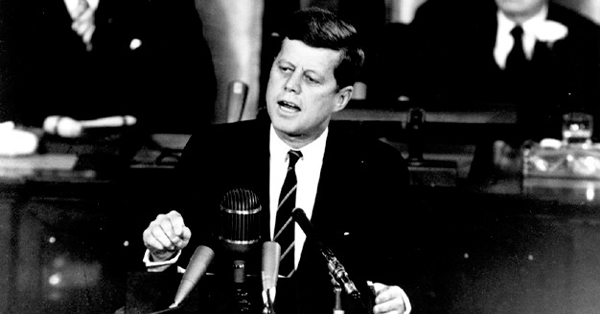5 Leadership Lessons from the Space Race

I’m a bit of a space geek, and, as a child, I hoped (and was certain) that by now I’d be vacationing on the moon and regularly jetting off to low earth orbit for regular trips. (Still waiting, BTW!).
A monumental achievement like that seemed likely as the luster of our national space program shone brightly as an example of what we could achieve together. And it’s that collective national memory of our moment of excellence that makes this week’s 50th anniversary of the Apollo 11 mission resonate so deeply with so many. Yet three years and five additional moon landings since Apollo 11, Apollo 17 lifted off from the moon’s surface on December 14, 1972… and we never returned.
As pundits, historians, and analysts opine on what our 50-year absence from the moon means, here are several lessons drawn from the heyday of the U.S. space program that you can use to enhance your organization.
Five Leadership Tips to Help Your Organization Achieve Your Mission
1. Create a shared vision.
On May 25, 1961, President John F. Kennedy outlined his vision “that this nation should commit itself to achieving the goal, before this decade is out, of landing a man on the moon and returning him safely to the Earth…” This speech set the tone for the next decade, but it wasn’t a mandate from the top. Instead, it was an invitation for “every citizen of this country as well as the Members of the Congress” to not only join but shape the course of how to achieve this vision. Today, we speak of audacious goals and strategic visions. All too often, though, leaders forget that their job is to create and nurture an organizational culture that enables everyone to buy into the shared vision by bringing the best of themselves to bear.
2. Set minor goals that advance your broader vision.
A shared vision in pursuit of a long-term goal can only be sustained if your team sees evidence of progress. For the U.S. space program of the 1960s, this meant navigating a set of goals that were each a significant accomplishment in their own right, yet existed as part of the larger “moonshot” goal. Rocket engines, lunar landing modules, un-crewed (followed by crewed) orbits, and spaceflights—all were designed to place humans on our closest satellite neighbor. If your organization’s vision has a timetable longer than a professional sport’s team’s season, then you need interim goals and milestones. Without those, people lose interest and your “vision” becomes unobtanium and nothing more than the view of a distant horizon.
3. Unify against a common enemy.
With the exception of Nazis, the U.S.S.R. may be the greatest external monolithic boogeyman that the United States has ever faced. And nothing bonds a band of independent tribespeople (or fifty states with numerous cultural subsets) faster than a credible external threat. The U.S. was united in its battle against communism, which is what enabled us to go from continually blowing up test rockets to walking on the moon eight years later.
Your organization isn’t charged with battling communism worldwide, yet you are likely united against some common enemy. You might be a nonprofit focused on eliminating poverty, an engineering lab dedicated to consumer safety through product testing, or any number of a million other companies with a different adversary. The point is that you have an enemy whom you’re battling. It might be physical, mental, or conceptual, but it exists and is part of your purpose. Figure out who that enemy is, then harness the power of your tribe to do battle.
4. Recruit the best possible talent.
By 1966, 420,000 people were working for NASA, and its quest for excellence was firmly imprinted upon our national consciousness (as evidenced by the phrase “it’s not rocket science” eclipsing “it’s not brain surgery” in popularity by the early 1980s). Notwithstanding the fact that NASA was very white and very male during the 1960s, it did garner a reputation for hiring the best and brightest. And people fell over themselves to be part of NASA’s grand quest. Creating a culture that celebrates and rewards excellence in pursuit of a shared vision is an unstoppable combination. Is your organization setting the table to recruit high-level “A-players” across the board, or are you simply looking for “good enough?”
5. Fail. Learn. Iterate. Repeat.
Much has been made of the mantra “fail fast.” Yet this principle was embodied by the U.S. space program long before Silicon Valley embraced it to bring you online dating and the overnight delivery of consumer goods. In the 1950s and 60s, we regularly blew up rockets on the launch pad, crashed test vehicles into the ground, and, tragically, killed a few of our heroes. But every time we failed, we learned. In business, failure can be expensive, prompting many organizations to adopt a risk-averse mentality that rewards success while simultaneously punishing failure. If your organization has a big vision and is chasing a larger set of goals, there will be failures. The only question is whether you’ll celebrate your failures, learn from them, and improve or punish the offenders and create a culture incentivizing conformity and a “we’ve always done it this way” mentality.
My hope is that someday soon private industry will apply the lessons from the U.S. space program’s glory days to provide the moon vacation that so many of us still pine for. Until then, you and I will have to settle for applying those lessons here on earth. But give me a call if you’re working on your vision and want some perspective… especially if that vision involves a rocket.





